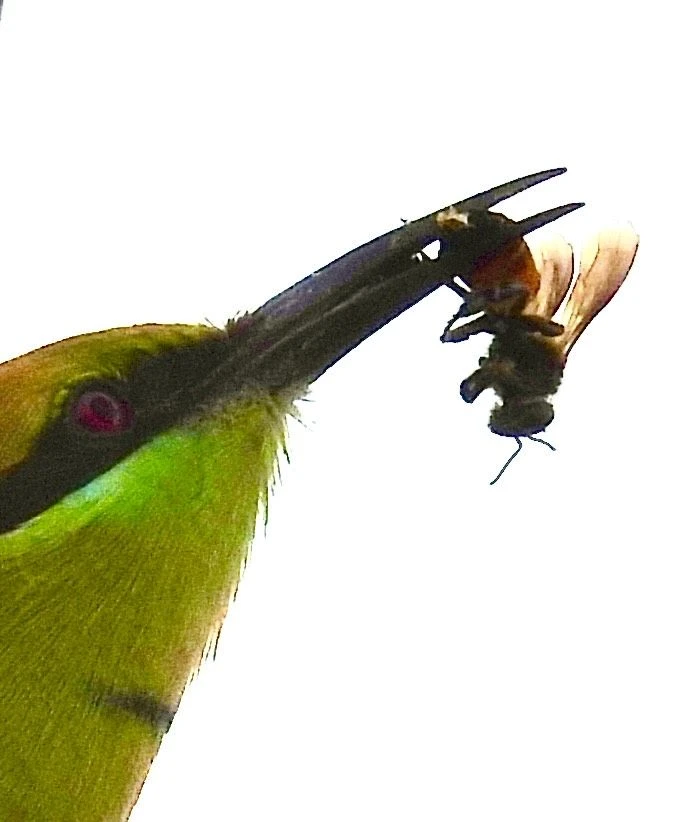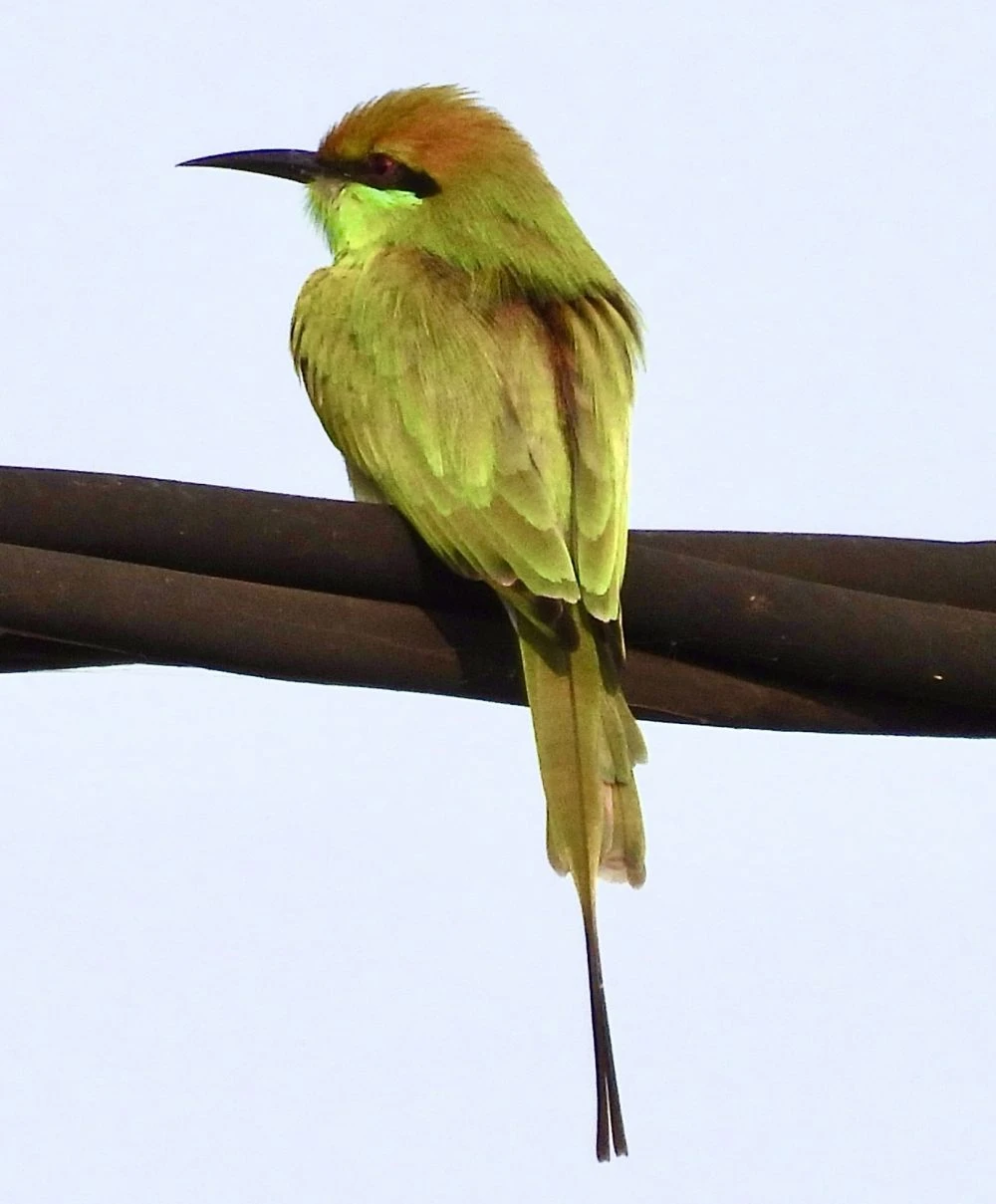Photo courtesy: Vinita Agrawal

Vinita Agrawal
It’s world is a dome of brilliant blue, a canvas for the sun that warms its emerald feathers. The Green Bee-eater, a jewel of arid lands, makes its home not in a dense, tangled forest, but a kingdom of open skies and sun-baked earth. You will find its kin and the bird itself across the plains of India, throughout sub-Saharan Africa, and in the scrublands of Southeast Asia. Bee-eaters favour places where the ground is soft and the air is thick with the hum of insects—riverbanks, grasslands, and the edges of cultivated fields. Their one non-negotiable demand is a plentiful supply of low, bare perches. A fence post, a dead branch, a telephone wire; these are their watchtowers, their dining tables, and the stages from which they perform their aerial ballets.
From their favourite perch on a weathered acacia branch, their day begins with the sun. Their first order of business is a survey of their domain. Their eyes, sharp and capable of discerning the subtlest movement, scan the air. They are not just looking for any insect; they are connoisseurs, specialists. The air is a menu, and their preferred dish is, as their name suggests, bees. But their diet is not limited to them; wasps, hornets, dragonflies, and any other flying insect unfortunate enough to cross their path will also suffice.
Hunting is an art form. They spot a honeybee hovering near a patch of flowering scrub. In an instant, they are airborne, a flash of green and turquoise. Their flight is not a straightforward charge; it is a series of elegant, fluid twists and turns, a masterclass in aerodynamics. They snatch the bee from the air with an audible click of their slender, curved bills. But the work is not yet done. A bee is not just a meal; it is a packet of protein with a venomous sting. They are no fools. They return to their perch, the bee held firmly in their bills. With a practised motion, they begin to thrash it vigorously against the branch. Thwack, thwack, thwack. They are not being cruel; they are being practical. They are removing the sting and squeezing out the venom. Once satisfied, they toss their head back and swallow the now-safe breakfast whole. This ritual is repeated dozens of times throughout the day, a relentless and necessary pursuit of energy.
As the heat intensifies, the social fabric of the colony comes alive. They are gregarious birds, living in small, noisy flocks. Their communication is a constant, melodious trilling, a series of "tree-tree-tree" calls that bind them together. They preen each other’s feathers, a gesture of social bonding that also helps maintain the impeccable condition of their plumage. Sometimes, a group of birds will engage in a breathtaking display, soaring high together, their synchronised flight, a shimmering cloud of green against the blue, before diving and swooping back to their perches in a chorus of cheerful calls.
When the seasons turn and the rains approach, a new urgency stirs within the flock. It is the time for breeding. The air becomes thick with the scent of damp earth, the perfect condition for their most arduous task: excavation. The mates, having strengthened their bond through courtship, feeding of choice insects, begin the back-breaking work of digging their nest. They choose a vertical sandbank, often near a river or a man-made cutting. Using their bills as picks and their tiny feet as shovels, they chip away loose soil and take turns digging a long, narrow tunnel. It can take them weeks to create a burrow that is sometimes over a meter long, a safe, dark chamber at its end where their future will be cradled.
Inside that cool, earthen chamber, the female lays her small, glossy white eggs—typically four or five. Both the male and the female share the duty of incubation, one of them always keeping the eggs warm while the other hunts and stands guard. This is a vulnerable time, and the birds are fiercely protective. After the eggs hatch, their lives become a relentless cycle of hunting. The chicks are insatiable, their gaping mouths a constant demand. They work from dawn until dusk, catching hundreds of insects each day, ensuring each morsel is diligently de-venomed before being delivered. Actually, they are not alone in this endeavour; often, a helper, usually an offspring from a previous year who has not yet bred, assists them in feeding the new brood—a testament to the cooperative spirit of the bee-eater.

When the fledglings finally emerge, blinking, into the sunlight, they are clumsy at first, their flights short and uncertain, but they soon learn the art of the hunt. They will join the flock, adding their voices to their trilling chorus. As the sun set, paints the sky in hues of orange and purple, it seems as though the birds feel a deep connection to this cycle of life. They are a mere flicker of emerald in a vast landscape, but here, on the sun-warmed perch, surrounded by many other bee-eaters, they are home. This is their world, and the green bra-eater is its gleaming, buzzing, vibrant heart.
In the dry, open grasslands of Africa and Asia, where green bee-eaters are often found, there is a constant, bustling drama between predators and prey. They have a particular problem: large, grazing animals like cattle, water buffalo, and even large antelope.
These great beasts, as they plod along, stir up a virtual insect blizzard. Grasshoppers, flies, and—most importantly for the bee-eater—bees and wasps are flushed from the grass, providing a rich and easily accessible food source. However, getting this food is dangerous. Flying right in amongst the stomping, thundering hooves of a herd is a recipe for becoming a feathered pancake. So, the green bee-eaters has developed a brilliant strategy. They don't just follow the herds; they ride them.
It's a common and delightful sight to see a small flock of these glittering emerald birds flitting around a water buffalo. But the most interesting part is when they land. They don't just perch on a nearby branch. They will boldly alight directly on the backs of the large animals.
From this magnificent, mobile vantage point, they are perfectly safe from the trampling feet below. They become living insect-sweepers. As the buffalo or cow walks, insects fly up right in front of the bird's face, and with the quick, precise flight of an ace pilot, the bee-eater darts out, snatches its prey, and returns to its moving perch.
This behaviour is so characteristic that it has earned the green bee-eater and its relatives the nickname "feathered cowboys." They have essentially domesticated the local megafauna, using them as their personal transportation and insect-flushing machines without the animal having any say in the matter. It's a perfect example of commensalism—a relationship where one species benefits (the bird gets easy food) and the other is unaffected (the buffalo barely notices its tiny, colorful passengers). Picture this - a dazzling green and turquoise bird, calmly riding a water buffalo across the savannah, waiting for its next meal to be served.
To learn more about birds visit - https://early-bird.in/the-wonder-of-birds
Vinita Agrawal is a poet, editor, independent researcher and birder. She has written and edited sizeably on the environment.




